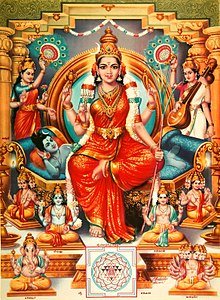Celebrating Hindu Heritage Month: October 2021


The motto of the Hindu Heritage month in 2021 is Vasudev Kutumbakam a Sanskrit phrase meaning One world one family. Please register at www.Hindumonth.org and follow us on Social Media to participate.
The Hindu American population is currently estimated to be 4 million strong and is the fastest-growing immigrant group in the country. Having reached the critical mass, it naturally wants to spread its wings and build a proactive outreach. To create a broader understanding of what Hinduism stands for and what Dharma offers to the world, The World Hindu Council of America (VHPA) has partnered with various organizations in North America and aims to raise awareness and celebrate the true ethos and culture of the Hindu civilization and the Hindu American Community.
One such step is to celebrate October as Hindu Heritage Month (HHM), to highlight one of the most auspicious months in the Hindu Calendar. As many as 50 Indian American organizations have already joined hands with World Hindu Council to celebrate Hindu Heritage Month (HHM). Many more are expected to engage in the coming weeks.
“I am excited to know that the time may come when people will know Diwali and Navaratri, as well as they, know Hannukah, Christmas, and Kwaanza,” said Shreya, one of the students associated with (Hindu Student Council) HSC a participating organization.
Dr. Jai Bansal, vice president of WHC asked a valid and pertinent question. “How many times have you attended a multi-faith religious gathering, to find that the Hindu voice is conspicuous by its absence? It is our own fault as we do not share our culture enough with the world or build representation. Lack of knowledge about Hinduism will create misconceptions and leave us on the sidelines. Hence events such as HHM are vital to assimilate the growing Hindu American population into the American melting pot.”
As many Hindu Americans settle in as US citizens, they represent significant cultural diversity in the country and are a bulwark in the financial, technological, and academic worlds. Their strong family values, high educational qualification, and deep respect for the law make Hindu Americans quiet but strong contributors to the social fabric of United States.
Celebrating Hindu Heritage Month is a way to highlight the lesser-known facts about Hindu Dharma and bring out positive elements of their cultural heritage. The focus this year is to weave some unique concepts of Hinduism like The Sacred Feminine, Fasting, Sustainability, and their religious symbols such as Bindi, Tilak, Swastika, and Om.
Hindu traditions offer a year-round opportunity for celebration, fasting, sustainable living, and positive symbolism like Swastika and Om. However, these symbols are most prominently displayed during the months of Asvina & Kartik (months of the Hindu lunar calendar roughly coinciding with September and October months of the Gregorian calendar) when a series of festive occasions are celebrated, such as the 9 days of Navratri, Vijay Dashami, Karwa Chauth and Diwali.

The Sacred Feminine: The feminine as a complementary force is central to the worship of the Goddess in Hinduism. As Tagore said, “Where there is Woman, there is Magic…For women are not only the deities of the household fire but the flame of the soul itself.” The Hindu scriptures are replete with sacred verses celebrating Shakti (roughly translated as energy or motive force), an attribute considered to be feminine in Hindu tradition.
The 9-day festival of Navaratri is a women-centric celebration and highlights the important role of women as the giver and sustainer of life, including elements like a seed, water, food, and land in pre-colonized India. As such Vandana Shiva, the relentless crusader for sustainability and the right to save seeds has always maintained that women power in Asia and Africa, and their intervention in agriculture helped the Sustainability process and kept earth and air and water sacred, pure, and revered due to a sense of collective cooperative ownership. It saved the exploitative and corrupt corporate style of extraction economies. Inherent to the concept was the idea that we are keepers of the earth and its resources, not the owners.
Duty before self.
As such that idea of Dharma driven by a sense of sacrifice and service is central to ancient Hindu society unlike modern concepts of entitlement. Fasting was thus important to Hindu society. In fact, 200 days were offered as a choice for fasting, and most people fasted on certain holy days, with Navaratri being one of the key time zones for fasting. The benefits of Fasting with no food for the entire day are well known and well researched.

Swastika Finally, many Hindu organizations are keen to use this opportunity to educate people about the variously different connotations of the Swastika, which in Sanskrit means “good symbol” Swastika at one point was a universal symbol and called by various different names in various traditions and faiths. The conflation of Swastika with Hitler’s Hakenkreuz or hooked Cross is unfortunate and pervasive and causes much confusion and pain for followers of Buddhism, Hinduism Jainism, and even Native Americans and other cultures that associate Swastika with well-being, spirituality, and good fortune. Hindu Heritage Month may offer a good opportunity to host workshops that will clear these misconceptions.
The motto of the Hindu Heritage month in 2021 is Vasudev Kutumbakam a Sanskrit phrase meaning One world one family. Please register at www.Hindumonth.org and follow us on Social Media to participate.
DISCLAIMER: The author is solely responsible for the views expressed in this article. The author carries the responsibility for citing and/or licensing of images utilized within the text.
